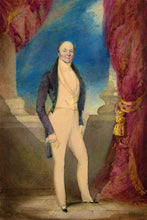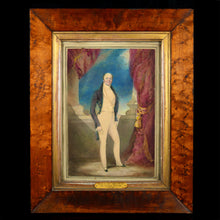Waterloo Cavalry General - Sir Arthur Clifton, 1840
- Regular price
- £1,400
- Sale price
- £1,400
- Regular price
-
- Unit price
- /per
Adding product to your cart
45cm x (17.5in) x 36cm (14in)
Watercolour on paper. Full length portrait of General Sir Arthur Benjamin Clifton (1771-1869), in evening dress by Queen Victoria’s Principal Painter in Ordinary Sir George Hayter (1792-1871). Contained in period maple wood frame.
On 18 June 1815 at Waterloo Lieutenant-Colonel Arthur Clifton rode at the head of his regiment in the charge of the Union Brigade, so-called because it included English, Scottish and Irish regiments - the 1st Royal Dragoons, 6th Inniskilling Dragoons supported by the 2nd Royal North British Dragoons (Scots Greys). The brigade made great slaughter amongst the disorganised French columns of d'Erlon's I Corps, and was famously commanded by Major-General William Ponsonby. Ponsonby’s charger became mired in mud and he was set upon by French lancers who failing to make him a prisoner killed him, during an abortive rescue attempt by Union Brigade troopers. Command of the brigade thus devolved on Colonel Hamilton of the Scots Greys, who was in turn killed, before passing to Clifton of Royals, in the final stages off the battle.
Read more
Sir Arthur was a lineal descendant of Avaredus de Clifton, a follower of William the Conquer, who was rewarded with lands in Nottinghamshire. Arthur was the third son of Sir Gervase Clifton, 6th Baronet (1744-1815), sometime High Sheriff of Nottinghamshire. Educated at Rugby School from 1783, he entered the Army in 1794, and went out the to the Peninsular War as a major in the 3rd Dragoon Guards in May 1809. In July of that year he commanded a squadron of the 3rd DG in covering and supporting four Spanish guns at the Battle of Talavera. He afterwards took part in the Battle of Busaco; the pursuit of Marshal Massena, in which he captured prisoners and baggage; the Battle of Fuentes de Oñoro; the actions of Nove d’Aver, El Bodon, Fuentes Guinaldo, Aldea de Ponte, and several engagements during the retreat from Salamanca to Cuidad Rodrigo. He led a squadron of the 1st Royal Dragoons in a charge against French infantry under General Clauset near Salamanca, killing and capturing upwards of a hundred of the enemy. In 1813 he commanded a cavalry brigade at Vittoria, for which he received a clasp to his Army Gold Medal for Fuentes de Oñoro. He further received the Military General Service medal with clasps for Talavera, Busaco, and Toulouse.
He was appointed to the Russian orders of St. Anne and St. Vladimir, and was made a Knight Commander of the Bath in Queen Victoria’s Coronation Honours 1838, and raised to Knight Grand Cross in 1861. A bachelor, he died aged nearly 100 at his Brighton residence, and mourned by servants and tenantry was afterwards interred in his ancestral village of Clifton in Nottinghamshire.






